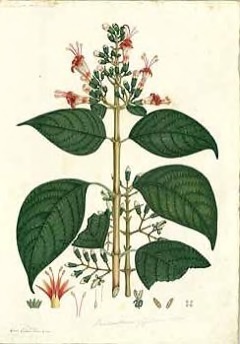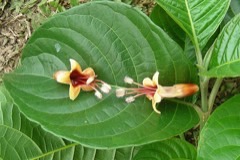 |
|
edibleplants.org |
 |
| Wikimedia.org - Dick Culbert from Gibsons, B.C., Canada |
Translate this page:
Summary
Physical Characteristics

 Trichanthera gigantea is a deciduous Tree growing to 5 m (16ft) by 4 m (13ft) at a fast rate.
Trichanthera gigantea is a deciduous Tree growing to 5 m (16ft) by 4 m (13ft) at a fast rate.
See above for USDA hardiness. It is hardy to UK zone 10. The flowers are pollinated by Bats, Birds, Ants, Bees. The plant is not self-fertile.
It can fix Nitrogen.
Suitable for: light (sandy), medium (loamy) and heavy (clay) soils, prefers well-drained soil and can grow in nutritionally poor soil. Suitable pH: mildly acid, neutral and basic (mildly alkaline) soils and can grow in very acid soils.
It can grow in semi-shade (light woodland) or no shade. It prefers moist soil.
UK Hardiness Map
US Hardiness Map
Synonyms
Besleria surinamensis Miq. Clerodendrum verrucosum Splitg. ex de Vriese Ruellia gigantea Humb. & Bonpl.
Plant Habitats
Edible Uses
Edible Parts: Shoots
Edible Uses:
Sprouts are eaten in maize porridge[418 ]. This almost certainly refers to the young shoots, since it is very difficult to germinate the seed[K ].
References More on Edible Uses
Medicinal Uses
Plants For A Future can not take any responsibility for any adverse effects from the use of plants. Always seek advice from a professional before using a plant medicinally.
Blood tonic Galactogogue
The plant is a blood tonic and galactagogue. It is used to treat nephritis and to promote the flow of milk in nursing mothers[415 ]. The plant is given to domestic animals, it is used to treat colic and hernia in horses, and retained placenta in cows[415 ].
References More on Medicinal Uses
The Bookshop: Edible Plant Books
Our Latest books on Perennial Plants For Food Forests and Permaculture Gardens in paperback or digital formats.

Edible Tropical Plants
Food Forest Plants for Hotter Conditions: 250+ Plants For Tropical Food Forests & Permaculture Gardens.
More

Edible Temperate Plants
Plants for Your Food Forest: 500 Plants for Temperate Food Forests & Permaculture Gardens.
More

More Books
PFAF have eight books available in paperback and digital formats. Browse the shop for more information.
Shop Now
Other Uses
Charcoal Fencing Fodder Fuel Hedge Pioneer Soil stabilization Wood
Agroforestry Uses: The plant is used as a hedge or living fence; as a shade tree in coffee plantations; and to prevent stream bank erosion[418 ]. The plant can be grown in association with a range of over-story agroforestry species due to its shade tolerance. It has been grown underneath bananas, Leucaena and Gliricidias[415 ]. A fast-growing plant, it can be used as a pioneer species when restoring naive woodland[625 ]. Other Uses: The wood is cream-coloured or pale brown, with no sharp distinction between the sapwood and heartwood. It has a slightly foetid odour, but no distinctive taste; is straight-or wavy-grained; coarse-textured; light in weight and rather soft, but strong for its weight[453 ]. It requires a sharp knife to cut smoothly across the grain; stains readily in drying[453 ]. Of low quality, it is only suitable for making light packing boxes or similar unfinished products[625 ]. The wood is used for fuel and to make charcoal[625 ]. Cultivated as an animal fodder and fed to ducks, pigs, and rabbits. Its leaves are relatively rich in protein. It has veterinary uses in Colombia, where it has been used to treat horse colic and retained placenta in cows.
Special Uses
Carbon Farming Coppice Food Forest Hedge Nitrogen Fixer
References More on Other Uses
Cultivation details
Fodder: Bank Management: Coppice Minor Global Crop
A plant of the humid, lowland tropics, where it is found at elevations up to 400 metres. It grows best in areas where annual daytime temperatures are within the range 27 - 33°c, but can tolerate 20 - 38°c[418 ]. The plant can survive temperatures down to about -1°c[418 ]. The plant does not tolerate frost[418 ]. It prefers a mean annual rainfall in the range 1,500 - 3,000mm, but tolerates 1,000 - 5,000mm[418 ]. Growing well in full sun, the plant also has considerable shade tolerance[418 ]. It is well adapted to acid infertile soils[418 ]. Although commonly found on stream banks, the plant requires well-drained soils[418 ]. Prefers a pH in the range 5 - 6.5, tolerating 4.5 - 7[418 ]. A fast-growing plant[625 ]. The vigorous regrowth of the plant under heavy cutting regimes has led to speculation that nitrogen fixation may occur through the action of mycorrhiza or other organisms[415 ]
Carbon Farming
-
Fodder: Bank
Fodder banks are plantings of high-quality fodder species. Their goal is to maintain healthy productive animals. They can be utilized all year, but are designed to bridge the forage scarcity of annual dry seasons. Fodder bank plants are usually trees or shrubs, and often legumes. The relatively deep roots of these woody perennials allow them to reach soil nutrients and moisture not available to grasses and herbaceous plants.
-
Management: Coppice
Cut to the ground repeatedly - resprouting vigorously. Non-destructive management systems maintaining the soil organic carbon.
-
Minor Global Crop
These crops are already grown or traded around the world, but on a smaller scale than the global perennial staple and industrial crops, The annual value of a minor global crop is under $1 billion US. Examples include shea, carob, Brazil nuts and fibers such as ramie and sisal.
References Carbon Farming Information and Carbon Sequestration Information
Temperature Converter
Type a value in the Celsius field to convert the value to Fahrenheit:
Fahrenheit:
The PFAF Bookshop
Plants For A Future have a number of books available in paperback and digital form. Book titles include Edible Plants, Edible Perennials, Edible Trees,Edible Shrubs, Woodland Gardening, and Temperate Food Forest Plants. Our new book is Food Forest Plants For Hotter Conditions (Tropical and Sub-Tropical).
Shop Now
Plant Propagation
Seed - best sown as soon as it is ripe in a partially shaded position in a nursery seedbed[625 ]. Germination rates are very poor, generally 0 - 2%[337 , 415 ], with the seed sprouting within 25 - 35 days[337 ]. Seedlings are usually ready to be planted out about 6 months after germination[337 ]. Stem cuttings will readily form roots in full sun or in light shade[415 ]. Cuttings 2.2 - 2.8mm in diameter, 20cm long and with at least 2 leaf buds are the most effective in striking roots, with a success rate of 92%[415 ]. Larger stem cuttings that are more than 1 metre long and 2cm in diameter can also be used in order to quickly produce a living fence[337 ]. Stems that contact the ground, either through bending or breakage, will root at the nodes to form new plants[415 ].
Other Names
If available other names are mentioned here
Aro, Asedera, Barriga, Yatago, Madre de agua, Suiban, Cenicero, Tuno, Naranjillo, and Palo de agua.
Native Range
SOUTHERN AMERICA: Costa Rica, Panama, Venezuela, Colombia, Ecuador, Peru (north)
Weed Potential
Right plant wrong place. We are currently updating this section.
Please note that a plant may be invasive in one area but may not in your area so it's worth checking.
None Known
Conservation Status
IUCN Red List of Threatened Plants Status : This taxon has not yet been assessed

Growth: S = slow M = medium F = fast. Soil: L = light (sandy) M = medium H = heavy (clay). pH: A = acid N = neutral B = basic (alkaline). Shade: F = full shade S = semi-shade N = no shade. Moisture: D = dry M = Moist We = wet Wa = water.
Now available:
Food Forest Plants for Mediterranean Conditions
350+ Perennial Plants For Mediterranean and Drier Food Forests and Permaculture Gardens.
[Paperback and eBook]
This is the third in Plants For A Future's series of plant guides for food forests tailored to
specific climate zones. Following volumes on temperate and tropical ecosystems, this book focuses
on species suited to Mediterranean conditions—regions with hot, dry summers and cool, wet winters,
often facing the added challenge of climate change.
Read More
Expert comment
Author
(Humb. & Bonpl.) Nees
Botanical References
Links / References
For a list of references used on this page please go here
A special thanks to Ken Fern for some of the information used on this page.
Readers comment
| Add a comment |
|
If you have important information about this plant that may help other users please add a comment or link below. Only comments or links that are felt to be directly relevant to a plant will be included. If you think a comment/link or information contained on this page is inaccurate or misleading we would welcome your feedback at [email protected]. If you have questions about a plant please use the Forum on this website as we do not have the resources to answer questions ourselves.
* Please note: the comments by website users are not necessarily those held by PFAF and may give misleading or inaccurate information.
To leave a comment please Register or login here All comments need to be approved so will not appear immediately.
|
Subject : Trichanthera gigantea
|
|
|
|